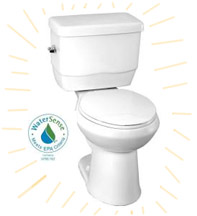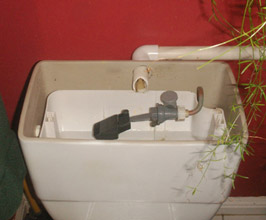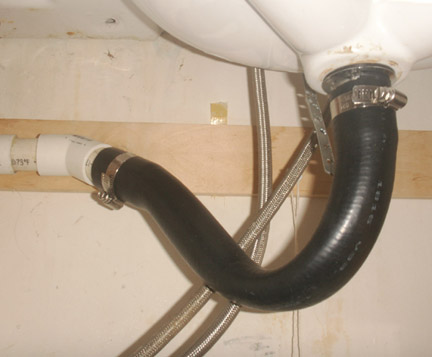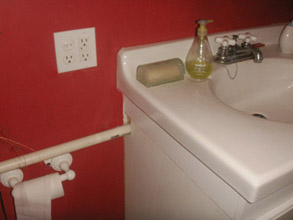 We are very lucky to have found a solution. We discovered at Home Depot a flapperless toilet for under $80. We took out our old Toto toilet and replaced it with this model. Our local water rebate covered 100% of the cost of the toilet. This toilet design uses a bucket that empties 100% of the water with each flush making it usable with grey water. If a toilet is deserving of love, then this is the toilet. Not only is it grey water compatible, but its also a low flow toilet [1.28 gallons] that delivers a decent flush (no miracles). Because you have direct control of the bucket, its also possible to give a partial flush equivalent to an expensive dual flush toilet. The bucket design also eliminates problems with a sweating tank and since there is no flapper, the ever constant problems with leaking are nearly eliminated.
We are very lucky to have found a solution. We discovered at Home Depot a flapperless toilet for under $80. We took out our old Toto toilet and replaced it with this model. Our local water rebate covered 100% of the cost of the toilet. This toilet design uses a bucket that empties 100% of the water with each flush making it usable with grey water. If a toilet is deserving of love, then this is the toilet. Not only is it grey water compatible, but its also a low flow toilet [1.28 gallons] that delivers a decent flush (no miracles). Because you have direct control of the bucket, its also possible to give a partial flush equivalent to an expensive dual flush toilet. The bucket design also eliminates problems with a sweating tank and since there is no flapper, the ever constant problems with leaking are nearly eliminated.
How we did it
 We took 1 inch pvc and ran it from under our bathroom sink, into the toilet tank. We have placed the tank backwards on the toilet. This means the back side of the bucket dumps downward and thus clears the pvc filler pipe. If we had put the tank on the right way round, this would have been much more problematic. FYI, I used some white high gloss paint to make the back of the tank look decent. You cant even tell its the back.
We took 1 inch pvc and ran it from under our bathroom sink, into the toilet tank. We have placed the tank backwards on the toilet. This means the back side of the bucket dumps downward and thus clears the pvc filler pipe. If we had put the tank on the right way round, this would have been much more problematic. FYI, I used some white high gloss paint to make the back of the tank look decent. You cant even tell its the back.
I thought it might be hard to drill a hole in the porcelain, turned out to be very easy after I purchased the correct drill bit. I used a 1.25 inch diamond hole saw. If that sounds expensive, it is. The bit was about $50 which would be easier to take if you were doing more than one toilet, or had a friend to share with. Someone who does granite counter tops might help you out or do it for a price without your having to buy the bit.
 Another minor problem is that this toilet is rather tall. In order to have a slope of 1 inch down for every 12 linear inches of pipe, we had to raise the sink about 6 inches. I used a small melamine shelf cut down to fill in the gap left between the counter top and base cabinet when we raised it up. It is almost unnoticeable. Since the sink is no longer connected to the sewer line, there was no need for a trap. However, we did sort of end up with a trap because our sink is very deep and we needed to jog up a bit before heading off across the wall. None of the hardware stores we visited had hose anywhere near the diameter needed to connect up with the pvc pipe. After a stroke of genius, I went to an automotive part store and purchased a radiator hose which worked brilliantly. Here it is connected with two hose clamps. That was about $20.
Another minor problem is that this toilet is rather tall. In order to have a slope of 1 inch down for every 12 linear inches of pipe, we had to raise the sink about 6 inches. I used a small melamine shelf cut down to fill in the gap left between the counter top and base cabinet when we raised it up. It is almost unnoticeable. Since the sink is no longer connected to the sewer line, there was no need for a trap. However, we did sort of end up with a trap because our sink is very deep and we needed to jog up a bit before heading off across the wall. None of the hardware stores we visited had hose anywhere near the diameter needed to connect up with the pvc pipe. After a stroke of genius, I went to an automotive part store and purchased a radiator hose which worked brilliantly. Here it is connected with two hose clamps. That was about $20.
 How does it work?
How does it work?
It work two different ways depending on our needs.
Mixed grey & potable water fill. We use this method when we have guests in the house. The toilet is still connected to the municipal water to supply but the valve is only partially on so that the tank fills slowly. While the tank is slowly filling, there is plenty of time for hand washing. This means that the tank is filled part with the grey water from washing and the balance of the 1.28 gallons is made up of fresh water. This saves perhaps a half gallon per flush depending on your hand washing habits. The really great part is that both the sink and the toilet behave exactly like a normal sink and toilet so that guests dont have to adapt.
Grey water only fill. For this method we turn the valve that supplies municipal water off. Hand washing alone doesnt provide 100% of water needed for each flush. Additional water is collected from washing faces and brushing teeth. Water can also be manually added to the tank either by running the faucet extra or adding cold water run off from the bathtub etc.
This practice has allowed us to reduce our daily water consumption. Cant tell you yet since we dont have our first bill.
Mellow yellow? We experiment with mixing the two water conservation methods and I think we have to advise against it. Mixing natural fertilizer with grey water gives you some rapid funk. We tried it only very briefly to see what would happen and can now spare you the question.
| We had on hand | We purchased |
1" PVC pipe some fittings seat bolts from old toilet lumber to raise sink pipe glue screws to mount lumber to cabinet
| Some additional pipe fittings $5-$10 Toilet $78 wax ring $4 radiator hose $20 2 pipe clamps $6 melamine shelf $10 1.25" diamond hole saw $50 |
- Log in to post comments